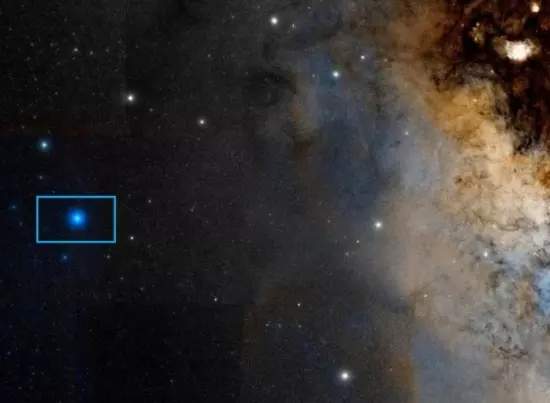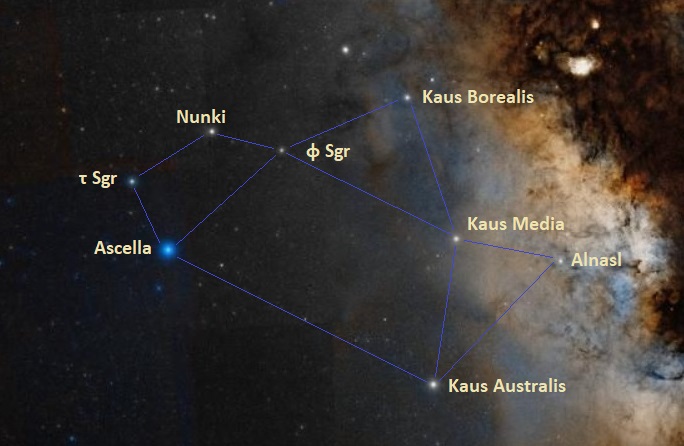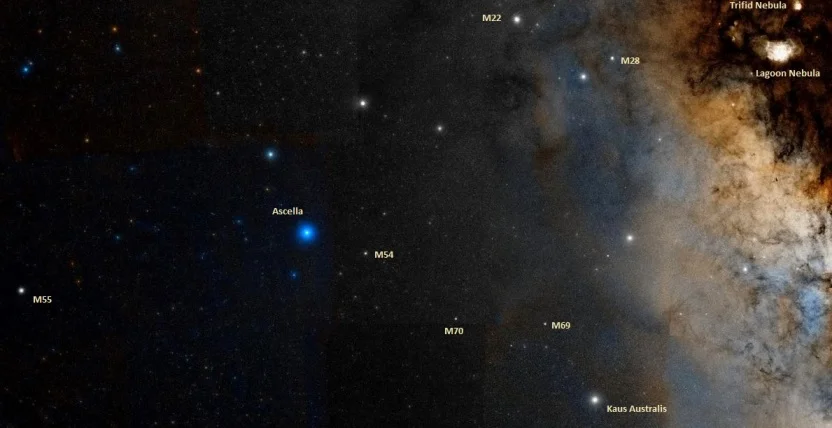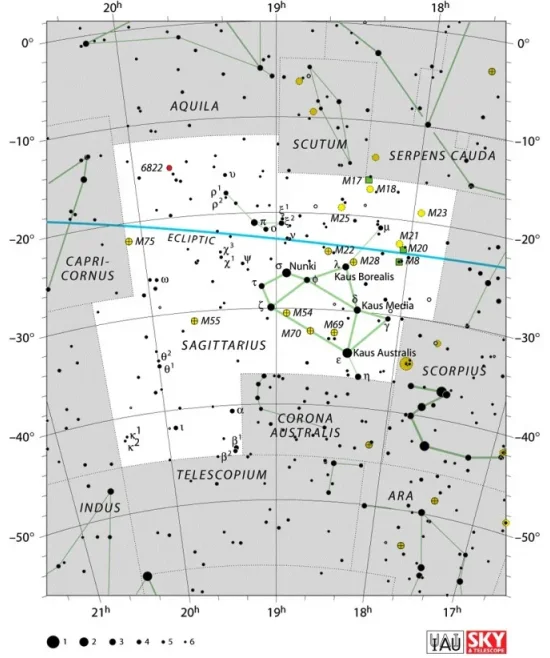Ascella, Zeta Sagittarii (ζ Sgr), is a multiple star system located in the constellation Sagittarius. It is the constellation’s third brightest star, after Kaus Australis and Nunki. The system has a combined apparent magnitude of 2.59 and lies at a distance of 88 light years from Earth.
Ascella marks the armpit of the Archer and is one of the stars that form the Teapot, a prominent asterism that dominates the western part of Sagittarius.
Star system
Zeta Sagittarii is a triple star system consisting of a binary pair – Zeta Sagittarii A and B – and a smaller companion, Zeta Sagittarii C.
Zeta Sagittarii A and Zeta Sagittarii B are likely hydrogen-fusing dwarfs with a little over 2 solar masses each. Their combined spectrum gives the stellar classification A2.5 Va. The component A has an apparent magnitude of 3.27 and Zeta Sagittarii B, 3.48. The estimated age of the system is between 500 and 710 million years.

Ascella (Zeta Sagittarii), image: Wikisky
Zeta Sgr A and Zeta Sgr B have an orbital period of 21.00 ± 0.01 years. They orbit each other with an eccentricity of 0.211 at a mean separation of 13.4 astronomical units (10.6 to 16.1 AU). The third component is considerably dimmer, a 10th magnitude star believed to be a class K dwarf. It is designated as Zeta Sagittarii C. The star is separated by 75 arcseconds from the main pair. If it is a member of the system, its estimated orbital period is at least 40,000 years.
Facts
Ascella is the 101st brightest star in the sky. It is only slightly fainter than Arneb in the constellation Lepus, Delta Centauri in Centaurus and Gienah in Corvus, and it just outshines Zubeneschamali in Libra, Unukalhai in Serpens, and Sheratan in Aries.
Ascella is moving away from the Sun with a radial velocity of 22 km s−1. It made its closest approach to the solar system between 1 and 1.4 million years ago, coming within about 7.5 light years, or 2.30 parsecs of the Sun. It was the brightest star in the sky in the period from 1,370,000 years ago to 1,080,000 years ago, shining at magnitude -2.74 at its peak.
Ascella has the Bayer designation Zeta Sagittarii despite being the constellation’s third brightest star. Sagittarius is one of the few constellations that do not reflect the rule of magnitude class which German uranographer Johann Bayer usually followed, assigning the Greek letters Alpha and Beta to a constellation’s first-magnitude or brightest stars. In Sagittarius, the three brightest stars were given the designations Epsilon (Kaus Australis), Sigma (Nunki) and Zeta (Ascella) Sagittarii, while the designation Alpha went to Rukbat (mag. 3.97), the constellation’s 16th brightest star. The stars sharing the designation Beta – Arkab Prior (Beta1 Sgr, mag. 4.01) and Arkab Posterior (Beta2 Sgr, mag. 4.29) – are the 15th and 18th brightest star in the constellation respectively.
Name
The name Ascella (pronunciation: /əˈsɛlə/) comes from a Late Latin word for “armpit.” The name was officially approved for Zeta Sagittarii A by the International Astronomical Union’s (IAU) Working Group on Star Names (WGSN) on September 12, 2016. Even though it formally applies only to the primary component of the Zeta Sagittarii system, the name is often used for the whole system and its individual components.
The Chinese name for Ascella is 斗宿一 (Dǒu Sù yī), or the First Star of Dipper. The Chinese Dipper asterism is formed by Ascella, Nunki, Phi Sagittarii, Tau Sagittarii, Kaus Borealis and Polis.
In the 17th century, Egyptian astronomer Al Achsasi al Mouakket listed the star as Thalath al Sadirah, meaning “the third returning ostrich,” in his Calendarium. The name was later translated into Latin as Tertia τού al Sadirah. In Arabic astronomy, the star was a part of an asterism known as Al Naʽām al Ṣādirah, the Returning Ostriches, which it formed with Nunki, Phi and Tau Sagittarii. Kaus Borealis represented the ostriches’ keeper.
Location
Ascella is easy to find because it forms a prominent asterism known as the Teapot with seven other bright stars of Sagittarius: Kaus Australis, Kaus Media, Kaus Borealis, Nunki, Alnasl, Tau Sagittarii and Phi Sagittarii. Ascella appears as the lower left star of the Teapot, marking the bottom of its handle.

The Teapot in Sagittarius, image: Wikisky
Ascella is also part of a smaller asterism known as the Little Milk Dipper, which it forms with Nunki, Kaus Borealis, Phi and Tau Sagittarii, the stars of the Teapot’s handle.
The star is located near several bright deep sky objects and can be used to find them. The globular cluster Messier 54, which likely belongs to the Sagittarius Dwarf Elliptical Galaxy (SagDEG) and not the Milky Way as once believed, can be found 1.5 degrees from the star in the direction of Kaus Australis. Messier 70, a Milky Way globular cluster, lies almost exactly halfway between the two stars, and its neighbour Messier 69 can be seen a little north of the imaginary line connecting the two stars. Another globular cluster, Messier 55, can be found roughly 17 degrees from the star, along an imaginary line extended from Kaus Media through Ascella eastwards.

Ascella, Messier 54, Messier 55, Messier 69 and Messier 70, image: Wikisky
Sagittarius is located in the southern sky and stays invisible to northern observers for most of the year. From northern latitudes, it can be seen above the southern horizon during the summer months. The best time of year to observe the stars and deep sky objects in the constellation is during the month of August.
Constellation
Ascella is located in the constellation Sagittarius. The 15th largest of the 88 constellations, Sagittarius lies in a dense Milky Way field in the direction of the Galactic centre. It is exceptionally rich in bright deep sky objects. It contains 15 Messier objects – more than any other constellation – including the nebulae Messier 8 (the Lagoon Nebula), Messier 17 (the Omega Nebula) and Messier 20 (the Trifid Nebula), the open clusters Messier 18, Messier 21, Messier 23 and Messier 25, and the globular clusters Messier 22 (Sagittarius Cluster), Messier 28 and Messier 75. The constellation is also home to the planetary nebulae NGC 6537 (the Red Spider Nebula), M 1-42 (the Eye of Sauron Nebula), NGC 6445 (the Box Nebula), and NGC 6818 (the Little Gem Nebula), and to the star-forming region NGC 6559.

Sagittarius constellation map by IAU and Sky&Telescope magazine
The 10 brightest stars in Sagittarius are Kaus Australis (Epsilon Sgr, mag. 1.85), Nunki (Sigma Sgr, mag. 2.05), Ascella (Zeta Sgr, mag. 2.59), Kaus Media (Delta Sgr, mag. 2.70), Kaus Borealis (Lambda Sgr, mag. 2.82), Albaldah (Pi Sgr, mag. 2.89), Alnasl (Gamma² Sgr, mag. 2.98), Eta Sagittarii (mag. 3.11), Phi Sagittarii (mag. 3.17), and Tau Sagittarii (mag. 3.326).
Ascella – Zeta Sagittarii
| Spectral class | A2.5 Va (A2 III + A4 IV) |
| U-B colour index | +0.05 |
| B-V colour index | +0.08 |
| Apparent magnitude | 2.59 (3.27/3.48) |
| Absolute magnitude | 1.11/1.32 |
| Angular size | 0.0100 arcminutes |
| Distance | 88 ± 2 light years (27.0 ± 0.6 parsecs) |
| Parallax | 36.98 ± 0.87 mas |
| Radial velocity | +22 km/s |
| Proper motion | RA: +10.79 mas/yr |
| Dec.: +21.11 mas/yr | |
| Mass (combined) | 5.26 ± 0.37 M☉ |
| Temperature | 8,799 K |
| Age | 500 to 710 million years |
| Rotational velocity | 77 km/s |
| Surface gravity | 3.90 cgs |
| Constellation | Sagittarius |
| Right ascension | 19h 02m 36.73024s |
| Declination | -29° 52′ 48.2279” |
| Designations | Ascella, Zeta Sagittarii, ζ Sgr, 38 Sagittarii, HD 176687, HR 7194, HIP 93506, GC 26161, GCRV 11482, SAO 187600, PPM 269230, CCDM J19026-2953AB, CPD-30 5798, IDS 18562-3001 AB, WDS J19026-2953AB, IRAS 18594-2957, 2MASS J19023670-2952484, TYC 6885-2837-1 |